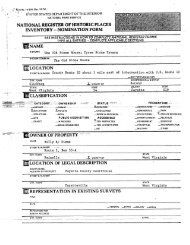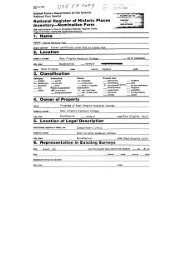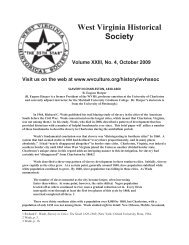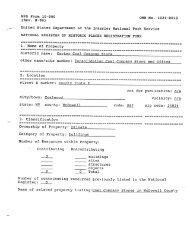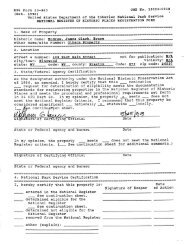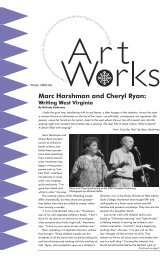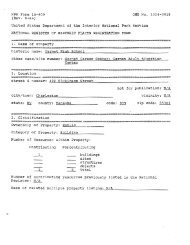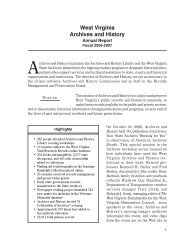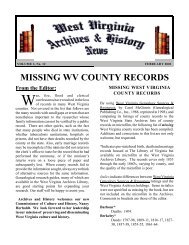Berkeley Springs Train Depot - West Virginia Division of Culture and ...
Berkeley Springs Train Depot - West Virginia Division of Culture and ...
Berkeley Springs Train Depot - West Virginia Division of Culture and ...
- No tags were found...
Create successful ePaper yourself
Turn your PDF publications into a flip-book with our unique Google optimized e-Paper software.
.UPS Form 10-300(Oct. i940)US& 73 UPYP o M ur n5mfgCnired States Deparrmenr ot the Interior xscional Park .';en iceYATIO3.AL &EGISTER OF HISTORIC PL.iCES REGISTRYTIO.~ FORJInot for ?ubiication: LAi-icinin: &zip code: ,224Jcertify that this Y norninat:on - request for 2exmination <strong>of</strong> t!igibliit?. rnts :hedocumentation st<strong>and</strong>ards for re!gis;erkis-?ropezies in [he Jationai R~gister <strong>of</strong> Hisonc Tlaczs m.cimeets the procedural <strong>and</strong> pr<strong>of</strong>essional requlremenrs set fonh in 36 CFR Part 6U In n;;. opir.!on.the propep Y meets - does not nee: thf Taronai Res~ster Cntena I recornmenc: - h r :h;spropertfl cons~dered sigmr -H natlonall> staten~de Y lo call^State or Federal agency <strong>and</strong> bureauDateIn my opinion. the propeg? - mse:s - does not meet the National Resists: sntsr.t(- See continuation sheer for adcitionai cements. )Signature <strong>of</strong>Ctrti&ing OI'ilcid TitieDareState or Federal agency m i bureauDate
<strong>Springs</strong> <strong>Train</strong> <strong>Depot</strong>Name <strong>of</strong> PropertyCounty <strong>and</strong> State4. National Park Service CertificationI, hereby certify that this property is: Signature <strong>of</strong> Keeper Date <strong>of</strong> Action- entered in the National Register- See continuation sheet.determined eligible for theNational RegisterSee continuation sheet.determined not eligible for theNational Register- removed from the National Registerother (explain):5. ClassificationOwnership <strong>of</strong> Property:(Check as many boxes as apply)privateX public-localpublic-Statepublic-FederalCategory <strong>of</strong> Property(Check only one box)2L building- district- sitestmc tureobjectNumber <strong>of</strong> Resources within Property(Do not include previously listed resources in the count.)ContributingNoncontributing1 0 buildingssitesstructuresobjects1 0 TOTALName <strong>of</strong> related multiple property listing &!A(Enter "NIA" if property is not part <strong>of</strong> a multiple property listing.)Number <strong>of</strong> contributing resources previously listed in the National Register L
s TradkpdName <strong>of</strong> PropertyCounty <strong>and</strong> StateCriteria Considerations(Mark "X" in all the boxes that apply.)Property is:A owned by a religious institution or used for religious purposes.B removed from its original location.C a birthplace or grave.D a cemetery.E a reconstructed building, object, or structure.F a commemorative property.G less than 50 years <strong>of</strong> age or achieved significance withln the past 50 years.Areas <strong>of</strong> SignificancePeriod <strong>of</strong> SignificanceSignificant DatesSignificant Person(Complete if Criterion B is marked above)Cultural AffiliationNarrative Statement <strong>of</strong> Significance(See continuation sheets.)
lev S~rings <strong>Train</strong>RepiName <strong>of</strong> Property. ..tyl <strong>West</strong> V1rgn.uCounty <strong>and</strong> State9. Major Bibliographical ReferencesBibliography(Cite the books, articles, <strong>and</strong> other sources used in preparing this form on one or morecontinuation sheets.)Previous documentation on file (NPS):preliminary determination <strong>of</strong> individual listing (36 CFR 67) has been requested.previously listed in the National Registerpreviously determined eligible by the National Registerdesignated a National Historic L<strong>and</strong>markrecorded by Historic American Buildings Survey #recorded by Historic American Engineering Record #Primary location <strong>of</strong> additional data:1L State Historic Preservation OfficeOther State agencyFederal agencyLocal governmentUniversityOtherName <strong>of</strong> Repository:Acreage <strong>of</strong> Property:UTM References (Place additional UTM references on a continuation sheet.)Quad Map: Hancoc-kVerbal Boundary Description(See continuation sheet.)Boundary Justification(See continuation sheet.)
Name <strong>of</strong> Property. ..ty. <strong>West</strong> VirymaCounty <strong>and</strong> State--11. Form Prepared By-- -- -Organization: Stuk&%qherdColled (J Date: Agmt2, 700QStreet & Number: 909 Telephone: 304-358-5411City or Town: State: U ZIP: 254UName: -sWater WorksStreet & Number: Wllkes & F& Streets Telephone: 304-258-1290City or Town: State: NY ZIP: 25411
(NPS Form 10-900)United States Department <strong>of</strong> the InteriorNational Park ServiceNATIONAL REGISTER OF HISTORIC PLACESCONTINUATION SHEETv S~ruqs <strong>Train</strong> De~otName <strong>of</strong> PropertyM~x~gin CounCountyJStateSection number 7 Page 1Architectural Description:The former Baltimore & Ohio Railroad depot is located at the north end <strong>of</strong> town on thecomer <strong>of</strong> US 522 or North Washington Street, on the west, <strong>and</strong> Williams Street on the south. Thebuilding is approximately five blocks from the town square <strong>of</strong> <strong>Berkeley</strong> <strong>Springs</strong>. Currentlyhousing the Bath Police Department <strong>and</strong> City Council chambers, the building st<strong>and</strong>s directlyacross from a WESTVACO pulpwood storage facility to the east that occupies much <strong>of</strong> theoriginal railroad yard. The depot st<strong>and</strong>s on an embankment, with the main depot tracks located onthe downslope, or eastern side, <strong>of</strong> the building. four-foot wide concrete sidewalk at one timecircled the building on all sides, with the tracks accessed from the depot by a series <strong>of</strong> concretestairs.The surroundings <strong>of</strong> the depot are quite varied, ranging from the pulpwood yardimmediately to the east, to a row <strong>of</strong> late 19Ih-early 20'~ century houses bordering CS 522 on thewest. A row <strong>of</strong> brick commercial buildings are visible across Williams Street to the south, <strong>and</strong>open lots border the building on the north. Modem l<strong>and</strong>scaping around the depot includes a smallherb <strong>and</strong> flower garden adjacent to the south wall <strong>and</strong> wooden benches <strong>and</strong> trash cans placedalong the walls beneath the broad, overhanging eaves.Overall, the depot is a one-story, rectangular red brick building with a bell-cast, red tilero<strong>of</strong>. All window <strong>and</strong> door openings are framed with a single row <strong>of</strong> contrasting brown bricks,<strong>and</strong> the main wall surfaces are laid in Flemish bond. The windows are the original, wood doublehungsashes <strong>and</strong> casements painted yellow <strong>and</strong> covered with aluminum-finish storm windows.The footprint <strong>of</strong> the depot measures roughly sixty-eight feet long by twenty feet wide, with thelong side running parallel to the tracks. The depot's most distinguishing architectural feature isthe red tile ro<strong>of</strong>, with its broad eaves extending several feet beyond the wall plane with openrafters <strong>and</strong> a beaded board s<strong>of</strong>fit.The north <strong>and</strong> south facades are nearly identical, both with two window openings above anarrow belt-course <strong>of</strong> brown bricks. The window openings in the south facade consist <strong>of</strong> a small,wood four-lite casement window on the left, <strong>and</strong> a tall, 214 double-hung sash window on the right.Directly above the windows is a two foot by six foot wood sign that reads "BERKELEYSPRINGS" in black letters on a yellow background. At one time, the north facade had two smallcasement windows, but the one on the left has been filled with plywood in order to accommodatean air conditioner.What was once the back <strong>of</strong> the depot faces west toward US 522, <strong>and</strong> has three doors <strong>and</strong>five window openings. The centered main passenger entrance is delineated by a section <strong>of</strong> thewall that steps out from the wall plane toward the sidewalk. Two 2/4 double-hung sash windowswith yellow, inset wooden kick-panels flank the main entry on each side. A rectangular transomwindow is present above the wood door, which features four panes <strong>of</strong> glass above a yellow insetpanel. Two small, paired, four-light casement windows are present to the right <strong>of</strong> the main entry.A 214 double-hung sash window paired with a wooden door <strong>and</strong> transom are located to the left <strong>of</strong>the main entry. This door opened into a room with access to the ticketmaster in the rear <strong>of</strong>fice.
(NPS Form 10-900)United States Department <strong>of</strong> the InteriorNational Park ServiceNATIONAL REGISTER OF HISTORIC PLACESCONTINUATION SHEETName <strong>of</strong> Property<strong>Depot</strong> Countv. <strong>West</strong> V i r -CountyIStateSection number 7 Page 2On the far left side <strong>of</strong> the west facade there is a wood double door that opens into the oldfreighthaggage room. Each door is divided into hvo recessed panels, with a larger panel on top<strong>and</strong> a smaller panel below. The panels consist <strong>of</strong> diagonal wood slats painted yellow <strong>and</strong> framedin black. The freight room is visually discernable from the main passenger areas by its slightlylower ro<strong>of</strong> pr<strong>of</strong>ile <strong>and</strong> a short, brick chimney on the ridge line.When the depot was still a transportation center, the east facade was the busiest side <strong>of</strong> thebuilding, as it faced the railroad tracks <strong>and</strong> the action <strong>of</strong> passing trains. In most respects, the eastfacade mirrors the west, except for the windows that are present on the sections <strong>of</strong> wall to the left<strong>and</strong> right <strong>of</strong> the main passenger door. These windows are tall, paired 214 double-hung sashes asopposed to the small casements <strong>and</strong> the paired door <strong>and</strong> window present on the west facade. Thepassenger <strong>and</strong> freight doors are identical to the west facade, <strong>and</strong> allowed people <strong>and</strong> baggage topass from one side <strong>of</strong> the building to the other. Thus carriages, <strong>and</strong> later automobiles, would drop<strong>of</strong>f or pick up passengers on the west side, <strong>and</strong> train passengers would enter or leave trains on theeast side. This design provided the most efficient movement <strong>of</strong> people <strong>and</strong> h<strong>and</strong>ling <strong>of</strong> baggage.The building did not have a passenger platform; the tracks were located several feet away from<strong>and</strong> below the depot, causing passengers to alight on a wide, concrete sidewalk <strong>and</strong> travel up aflight <strong>of</strong> concrete stairs to reach the shelter <strong>of</strong> the building.The interior <strong>of</strong> the depot is arranged much like others along the B&O. In this case, thebuilding is divided into a large, centrally located waiting area <strong>and</strong> a smaller, ladies waiting roomon the south end. The larger waiting room has a twelve foot high ceiling with the original, threeglobe hanging lights. White plaster walls are divided in half by beaded wood wainscoting paintedlight gray. The red terra cotta tile floor is still present <strong>and</strong> in a good state <strong>of</strong> preservation. A fourfoot by six foot ticket area is reached through an non-original Dutch door, but retains the ticketbooth sign. The station maser's telegraph <strong>of</strong>fice is located in a smd1 area approximately eight feetlong by ten feet wide with two windows facing the tracks. On the far north end <strong>of</strong> the depot is theold freight room, now used as a computer room. This space has been altered by the application <strong>of</strong>framing <strong>and</strong> dry wall over the interior freight doors <strong>and</strong> the addition <strong>of</strong> an air conditioner in one <strong>of</strong>the windows. This has retained the original look <strong>of</strong> the exterior freight doors. Restrooms in thedepot are intact, with white ceramic tile on the walls <strong>and</strong> beaded board wood stall doors that havetheir original green paint.St<strong>and</strong>ing at the edge <strong>of</strong> <strong>Berkeley</strong> <strong>Springs</strong> along its historic rail corridor, the <strong>Berkeley</strong><strong>Springs</strong> <strong>Train</strong> <strong>Depot</strong> retains much <strong>of</strong> its original integrity, both in materials <strong>and</strong> setting. It retainsits original form <strong>and</strong> materials, with most <strong>of</strong> the later modifications being reversible. It is alsoeasily identifiable as the historic entry point to the town during its peak years as a center <strong>of</strong>industry, agriculture, <strong>and</strong> tourism.
(NPS Form 10-900)United States Department <strong>of</strong> the InteriorNational Park ServiceNATIONAL REGISTER OF HISTORIC PLACESCONTINUATION SHEETName <strong>of</strong> Property<strong>Depot</strong>>lorpan County. <strong>West</strong> <strong>Virginia</strong>CountyIStateSection number 8 Page 1Statement <strong>of</strong> Significance:The <strong>Berkeley</strong> <strong>Springs</strong> <strong>Train</strong> <strong>Depot</strong> is significant under Criterion A for Transportation dueto its role as the principal hub for railroad activity in the town <strong>of</strong> <strong>Berkeley</strong> <strong>Springs</strong>. The depot isalso eligible under Criterion C for Architecture. The period <strong>of</strong> significance begins with theconstruction <strong>of</strong> the depot in 19 15 <strong>and</strong> extends to 1935 when passenger service ended.The opening <strong>of</strong> the B&O line was in direct response to the popularity <strong>of</strong> the to~vn'sfamous healing waters (the town was once named "Bath," marking the importance <strong>of</strong> the springs).The town's commercial <strong>and</strong> industrial growth is also linked to the railroad. as local s<strong>and</strong>. lumber.vegetable <strong>and</strong> fruit merchants all either opened new establishments or exp<strong>and</strong>ed old ones after therails reached the area. The rapid growth <strong>of</strong> commerce <strong>and</strong> passenger traffic led the B&O to buildthe present depot when its wood-frame predecessor proved inadequate to h<strong>and</strong>le the increasedvolume <strong>of</strong> traffic. At its height <strong>of</strong> productivity in the 1920s <strong>and</strong> 1930s. the railroad was used forshipping produce <strong>and</strong> pulpwood. It brought freight into primary businesses, such as VictorProducts, the Interwoven mill, the Ice House <strong>and</strong> Newbraugh's Feed <strong>and</strong> Supply.The depot is an important local architectural l<strong>and</strong>mark that symbolizes the bustling,thriving center <strong>of</strong> activity that once emanated from the railroad serving our town. The stationderives its unique architectural features from the Mission style, low-pitched tile ro<strong>of</strong> with its wide,overhanging eaves. It was designed <strong>and</strong> built by the B&O Railroad Company. Although it maybe much like other stations along the B&O line, it is the only station <strong>of</strong> this design still st<strong>and</strong>ing inMorgan County. Only one other station is still st<strong>and</strong>ing in the county, which is a frame buildingin Paw Paw.Located in the mountains <strong>of</strong> the eastern panh<strong>and</strong>le <strong>of</strong> <strong>West</strong> <strong>Virginia</strong>, Morgan County'shealing springs held significance for the Shawnee Indians who used the water as part <strong>of</strong> theirhealing ceremonies. White settlers soon discovered the springs as well, <strong>and</strong> in 1748 a youngGeorge Washington surveyed the area while working for Lord Fairfax. When the l<strong>and</strong>surrounding the springs was incorporated as the Town <strong>of</strong> Bath in 1776, Washington <strong>and</strong> hisfriends purchased many <strong>of</strong> the original lots. Washington later used his Bath property as anun<strong>of</strong>ficial summer White House. Because <strong>of</strong> this, many influential Americans became frequentvisitors to the spa <strong>and</strong> its healing waters.As fame <strong>of</strong> the springs grew, many well-known visitors including Charles Carroll, signer<strong>of</strong> the Declaration <strong>of</strong> Independence, <strong>and</strong> author Washington Irving came to take the waters.A golden opportunity seemed to be emerging, but access to the springs was problematic. Newpatrons arrived at the springs by stage coach from the B&O railroad station in nearby Sir John'sRun. Travelers paid a fee <strong>of</strong> one dollar for a perilous three mile journey over a twisted <strong>and</strong> ruttedwagon trail that crossed Warm <strong>Springs</strong> Mountain.
(NPS Form 10-900)United States Department <strong>of</strong> the InteriorNational Park ServiceNATIONAL REGISTER OF HISTORIC PLACESCONTINUATION SHEETSprws TramR.e@Name <strong>of</strong> PropertyJlwgan County. <strong>West</strong> Vir~inidCountyIStateSection number 8 Page 2By the late 19Ih century, influential people began to pressure the B&O for a spur linedirectly to the town, then known as <strong>Berkeley</strong> <strong>Springs</strong>, from Sir John's Run or Hancock, Maryl<strong>and</strong>.The local newspaper urged business men to write the railroad <strong>and</strong> lobby for thls spur. The April10, 1886, issue <strong>of</strong> The Mercury reported a meeting <strong>of</strong> citizens to petition the County Court tosubmit a proposition that would authorize a bond issue in the amount <strong>of</strong> $25,000 to purchasestock in the railroad. There was also a petition for <strong>Berkeley</strong> <strong>Springs</strong> to subscribe $5,000 for thesame purpose. The June 26'h issue <strong>of</strong> The Mercun reported that 105 citizens were for the bond<strong>and</strong> only four against it. Also at this time, 200 members <strong>of</strong> the <strong>West</strong> <strong>Virginia</strong> Press Associationmet at <strong>Berkeley</strong> <strong>Springs</strong> for their annual meeting. After experiencing the unpleasant jolting <strong>of</strong> thedangerous ride over Warm <strong>Springs</strong> Mountain, they wrote most fervently <strong>of</strong> the pressing need forthe spur line.On September 16, 1886, it was noted that the first cross ties had been laid for the newrailroad, known as the <strong>Berkeley</strong> <strong>Springs</strong> & Potomac. Construction took seven months, <strong>and</strong> onNovember I, 1888, the first train steamed into town. B&O Engine #55 with engineer HezWilliams, fireman Joseph Tyson, brakeman Frank Kesecker, <strong>and</strong> station master Murray Starnesarrived pulling a combined passenger <strong>and</strong> baggage car in a trip that took twenty-five minutes fromHancock, Maryl<strong>and</strong> <strong>and</strong> cost thirty cents. Old house cars were used for shelter until the woodframedepot was completed. The short train was met by the <strong>Berkeley</strong> <strong>Springs</strong> Coronet B<strong>and</strong>.Many citizens marked the event by traveling to Hancock in order to ride the train back into<strong>Berkeley</strong> <strong>Springs</strong>.The new railroad served more than the tourist trade, as several local businesses used theline for shipping their products. Cross ties <strong>and</strong> lumber were among the first commodities to beshipped to market on the line. When the first train reached town, several switches <strong>and</strong> side tracksto bark sheds were already under construction. In the decade following the railroad's construction,twenty canneries opened <strong>and</strong> shipped their products <strong>and</strong> produce via the railroad. From 19 10 untilthe middle 1 NOS, Newbraugh's Feed <strong>and</strong> Supply used the rail line for coal <strong>and</strong> other supplies. InMr. Cecil Arnbrose's recollections, fifty-three carloads <strong>of</strong> coal were delivered to Newbraugh's in1930; such heavy use caused the tracks to need repair, <strong>and</strong> Mr. Arnbrose hired men for thirty centsan hour to do the repairs. As business began to grow, the tracks were extended up Williams Streetfor the Interwoven Mill <strong>and</strong> Victor Products. U.S. Silica, a major s<strong>and</strong> mine operation, also usedthe railroad <strong>and</strong> is still in business today. Adjacent to the depot, the wood yard shipped pulpwoodto Luke, Maryl<strong>and</strong>, by rail between the years 1930 <strong>and</strong> 1984.Such rapid growth in tourism <strong>and</strong> industry soon made the old, wood-frame depot obsolete,<strong>and</strong> in 19 15 the B&O replaced it with the present brick <strong>and</strong> tile building. Passenger trafficincreased even more during WWI, when troop traffic passed through the area. The new depotserved the area well through the decade <strong>of</strong> the 1920s, but changing times by the early 1930s soonrendered it as obsolete as its predecessor. The B&O ended passenger train service to <strong>Berkeley</strong><strong>Springs</strong> in 1935, retaining only its still pr<strong>of</strong>itable freight service. People had to take a B&O motorbus, leased to one Mr. Unger, from <strong>Berkeley</strong> <strong>Springs</strong> to the train depot in Hancock. Maryl<strong>and</strong> ifthey wished to catch a train. Activity picked up again during WWII, once again as a result <strong>of</strong>
(NPS Form 10-900)United States Department <strong>of</strong> the InteriorNational Park ServiceNATIONAL REGISTER OF HISTORIC PLACESCONTINUATION SHEETName <strong>of</strong> PropertyDe~otCountyIState. ..<strong>West</strong> VlrgmaSection number 8 Page 3troop movements <strong>and</strong> telegraph activity. Mr. Floyd Hansrothe, train station master at <strong>Berkeley</strong><strong>Springs</strong> for over forty years, had the grave duty <strong>of</strong> receiving war news over the telegraph,including casualty reports. It was part <strong>of</strong> his job to h<strong>and</strong> deliver unfortunate news to localfamilies, requiring him to lock the depot <strong>and</strong> travel through all types <strong>of</strong> weather.In 1953, <strong>Berkeley</strong> <strong>Springs</strong> lost its final link to passenger rail service when the bus operatedby B&O contractor <strong>West</strong> <strong>Virginia</strong> Transportation Services was shipped to Dayton, Ohio. This actterminated over 100 years <strong>of</strong> rail service between the B&O <strong>and</strong> the town <strong>of</strong> <strong>Berkeley</strong> <strong>Springs</strong>. TheB&O retained ownership <strong>of</strong> the depot until 1968, when it was sold to the city. At the present time,the depot is owned by the <strong>Berkeley</strong> <strong>Springs</strong> Water Works, <strong>and</strong> is leased to the town <strong>of</strong> <strong>Berkeley</strong><strong>Springs</strong> for use as City Council chambers <strong>and</strong> a police station.Summary:The <strong>Berkeley</strong> <strong>Springs</strong> <strong>Train</strong> <strong>Depot</strong> is a significant architectural reminder <strong>of</strong> the town's late19'~ century <strong>and</strong> early 2oth century growth as a center <strong>of</strong> industry, agriculture, <strong>and</strong> tourism. It issignificant as an example <strong>of</strong> an important local transportation link that served the town from 1915to 1935. It is also significant as an example <strong>of</strong> railroad architecture with its Mission style details<strong>and</strong> fine state <strong>of</strong> preservation.
(NPS Form 10-900)United States Department <strong>of</strong> the InteriorNational Park ServiceNATIONAL REGISTER OF HISTORIC PLACESCONTINUATION SHEETey SprmgdkpdName <strong>of</strong> PropertyCounty. WVCountyIStateSection number 9 Page 1Bibliography:Books:Hollis, Jeffrey R. <strong>and</strong> Roberts, Charles S. Eastd R&O, 66s Neck <strong>of</strong> the Bottle." Baltimore, LMD:Barnard Roberts Publications, 1992Newbraugh, Frederick T. WarmSDnngs Volume I, 11, <strong>and</strong> 111. <strong>Berkeley</strong> <strong>Springs</strong>, WV:Self Published, 1976.Stover, John F. &tory <strong>of</strong> the Lafayette, IN: Purdue Research,1986.Interviews:Tours <strong>and</strong> interviews with Martin Duvall <strong>and</strong> John Hansrothe by Jacqueline Hovermale, April 18,2000, <strong>Berkeley</strong> <strong>Springs</strong>, WV.Newspapers:The News, November, 1888, January 1889, Morgan County, <strong>Berkeley</strong> <strong>Springs</strong>, WV.Maps:Tax Plat Map, <strong>Berkeley</strong> <strong>Springs</strong>, WV, Surveys, Morgan County Courthouse.
(NPS Form 10-900)United States Department <strong>of</strong> the InteriorNational Park ServiceNATIONAL REGISTER OF HISTORIC PLACESCONTINUATION SHEETv S w s Tram De~otName <strong>of</strong> PropertyCountyIStateSection number 10 Page 1Verbal Boundary DescriptionBeginning at the point <strong>of</strong> intersection <strong>of</strong> the easterly line <strong>of</strong> Williams Street with thesoutherly line <strong>of</strong> Washington Street, said point being 50.0 feet measured in a northerly directionalong the easterly line <strong>of</strong> Williams Street from centerline <strong>of</strong> track <strong>of</strong> the Baltimore <strong>and</strong> OhioRailroad Company's <strong>Berkeley</strong> <strong>Springs</strong> Branch extended to its intersection with the easterly line <strong>of</strong>Williams Street, thence with the southerly edge <strong>of</strong> Washington Street parallel to <strong>and</strong> distant 50.0feet measured at right angles in a northerly direction from centerline <strong>of</strong> said <strong>Berkeley</strong> <strong>Springs</strong>Branch N 29 degrees 04 minutes E 155.0 feet; thence S 60 degrees 56 minutes E 36 feet to apoint, said point being 14.0 feet measured at right angles in a northerly direction from centerline<strong>of</strong> track <strong>of</strong> said <strong>Berkeley</strong> <strong>Springs</strong> Branch at Valuation Station 320c54.6; thence parallel to <strong>and</strong>distant 14.0 feet measured at right angles in a northerly direction from said <strong>Berkeley</strong> <strong>Springs</strong>Branch S 29 degrees 04 minutes W 155.1 feet to a point in the easterly line <strong>of</strong> Williams Street;thence with said easterly line <strong>of</strong> Williams Street N 60 degrees 41 minutes W 36.0 feet to the point<strong>of</strong> beginning, containing 0.13 <strong>of</strong> an acre, more or less.Boundary JustificationThis is the property historically associated with the 19 15 <strong>Berkeley</strong> <strong>Springs</strong> <strong>Depot</strong>.As recorded by deed in Deed Book 76, page 163, November 8, 1968.
(NPS Form 10-900)United States Department <strong>of</strong> the InteriorNational Park ServiceYATIONAL REGISTER OF HISTORIC PL-ACESCONTINUATION SHEETtv. <strong>West</strong> Vir~m-Name <strong>of</strong> PropertyCountyiStateSection number Photo Page 1Name <strong>of</strong> Property: <strong>Berkeley</strong> <strong>Springs</strong> <strong>Train</strong> <strong>Depot</strong>Address:504 North Washmgton StreetTown: <strong>Berkeley</strong> <strong>Springs</strong>, WV 2511 1County:~Morgan CountyPhotographer:Jacqueline HovermaleDate: February 20,2000Negatives:WV SHPO, Charleston. W-VPhoto 1 <strong>of</strong> 3Photo 2 <strong>of</strong> 3:Photo 3 <strong>of</strong> 3:<strong>West</strong> facade, L'S 522 side. camera facing east.South facade, camera facing north. End <strong>of</strong> depot showing "BERKELEYSPRINGS" sign <strong>and</strong> flower garden.East facade <strong>and</strong> north facades, Track side, camera facing west.
RAI1,ROAI)TRACKSWASHINGTON STREET
BERKELEY SPRINGS TRAIN DEPOTMORGAN COUNTY, WEST VIXGINIATAX YAP
BBRKELEY SPRINGSlrIIyLy.11 ....... .UIYlb .......IYIYI....YMlIW U ........... D1lm a 1 ........ tm81 ... tnnY I U ........ I4m ...... ..UT





